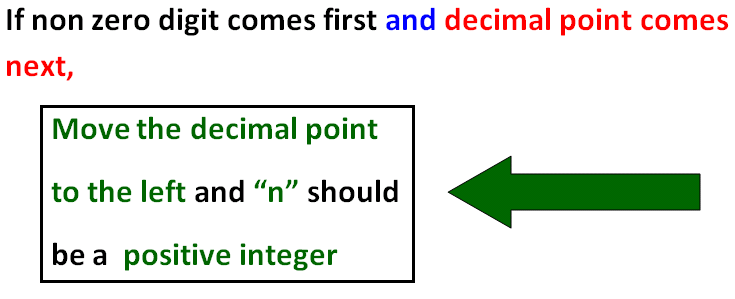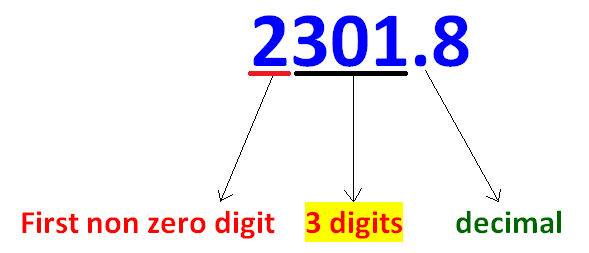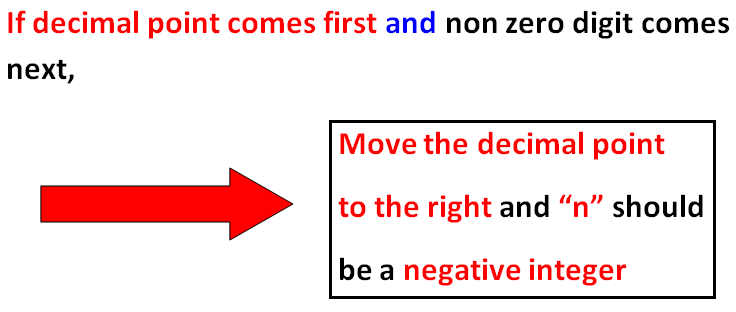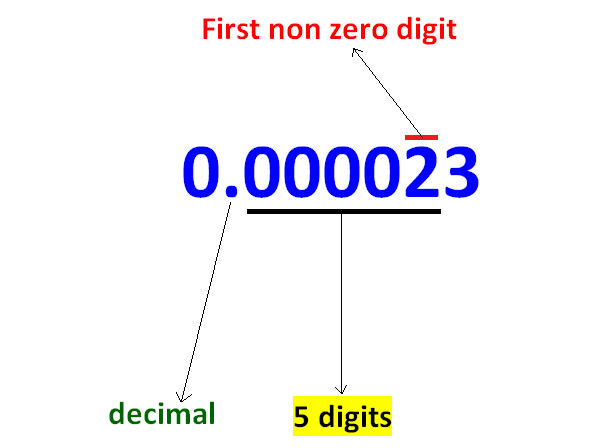SCIENTIFIC NOTATION RULES
Scientific notation is a standard way of writing very large and very small numbers so that they’re easier to both compare and use in computations.
Every number in the scientific notation must be in the form of
a x 10n
where 1 ≤ a < 10 and n must be a positive or negative integer.
To convert a number into scientific notation, first we have to identify where the decimal point and non zero digit come.
There are two cases in it.
Case 1 :

To move the decimal point to the left, we have to count number of digits as explained in the example given below.

According to the example given above, we have to move the decimal point 3 digits to the left and exponent of 10 should be 3 (positive integer)
When we do so, we get the scientific notation of the given number.
So,
2301.8 = 2.3018 x 103
Case 2 :

To move the decimal point to the right, we have to count number of digits as explained in the example given below.

According to the example given above, we have to move the decimal point 5 digits to the right and exponent of 10 should be -5 (negative integer)
When we do so, we get the scientific notation of the given number.
So,
0.000023 = 2.3 x 10-5
Important Note:
If we don't find decimal point at anywhere of the given number, we have to assume that there is decimal point at the end of the number.
For example,
2300000 ----> 2300000.
Here, the non zero digit comes first and decimal point comes next. So we have to apply case 1 to convert this number into scientific notation.
Solved Problems
Write the following numbers in scientific notation.
Problem 1 :
0.0007
Solution :
Here decimal point comes first at non zero digit comes next.
We have to move the decimal point to the right.
Number of digits from the decimal point to the first non zero digit is 4.
So, the decimal point has to be moved 4 digits to the right and exponent of 10 should be -4 (negative integer)
Therefore, the scientific notation of 0.0007 is
7 x 10-4
Problem 2 :
Write the given number in scientific notation.
28000
Solution :
Here we don't find decimal point in 28000. So we have to assume that there is decimal point at the end .
Then, 28000 ----> 28000.
Here non zero digit comes first and decimal point comes next.
We have to move the decimal point to the left.
Number of digits between the 1st non-zero digit and the decimal point is 4.
So, the decimal point has to be moved 4 digits to the left and exponent of 10 should be 4 (positive integer)
= 28000
= 2.8000 x 104
= 2.8 x 104
Problem 3 :
64 x 103
Solution :
Here we don't find decimal point in 64x 103. So we have to assume that there is decimal point at the end of 64
Then,
64 x 103 ----> 64. x 103
Here non zero digit comes first and decimal point comes next.
We have to move the decimal point to the left.
Number of digits between the 1st non zero digit and the decimal point is 1.
So, the decimal point has to be moved 1 digit to the left and exponent of 10 should be 2 (positive integer)
= 64. x 103
= 6.4 x 101 x 103
= 6.4 x 101 + 3
= 6.4 x 104
Problem 4 :
44 x 10-2
Solution :
Here we don't find decimal point in 44 x 10-2 So we have to assume that there is decimal point at the end of 44
Then,
44 x 10-2 ----> 44. x 10-2
Here non-zero digit comes first and decimal point comes next.
We have to move the decimal point to the left.
Number of digits between the 1st non zero digit and the decimal point is 1.
So, the decimal point has to be moved 1 digit to the left and exponent of 10 should be 1 (positive integer)
= 44. x 10-2
= 4.4 x 101 x 10-2
= 4.4 x 101 - 2
= 4.4 x 10-1
Problem 5 :
0.075 x 10-3
Solution :
Here decimal point comes first and non-zero digit comes next.
We have to move the decimal point to the right.
Number of digits from the decimal point to the first non zero digit is 2.
So, the decimal point has to be moved 2 digits to the right and exponent of 10 should be -2 (negative integer)
= 0.075 x 10-3
= 7.5 x 10-2 x 10-3
= 7.5 x 10-2-3
= 7.5 x 10-5
Kindly mail your feedback to v4formath@gmail.com
We always appreciate your feedback.
©All rights reserved. onlinemath4all.com
Recent Articles
-
Digital SAT Math Problems and Solutions (Part - 146)
Apr 18, 25 06:52 AM
Digital SAT Math Problems and Solutions (Part - 146) -
Logarithmic Derivative Problems and Solutions
Apr 16, 25 09:25 PM
Logarithmic Derivative Problems and Solutions -
Digital SAT Math Problems and Solutions (Part - 145)
Apr 16, 25 12:35 PM
Digital SAT Math Problems and Solutions (Part - 145)

